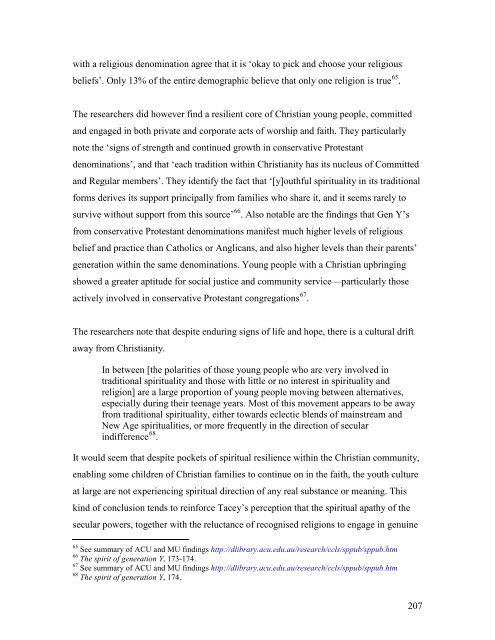Introductory notes for readers of this thesis - Theses - Flinders ...
Introductory notes for readers of this thesis - Theses - Flinders ...
Introductory notes for readers of this thesis - Theses - Flinders ...
You also want an ePaper? Increase the reach of your titles
YUMPU automatically turns print PDFs into web optimized ePapers that Google loves.
with a religious denomination agree that it is ‘okay to pick and choose your religiousbeliefs’. Only 13% <strong>of</strong> the entire demographic believe that only one religion is true 65 .The researchers did however find a resilient core <strong>of</strong> Christian young people, committedand engaged in both private and corporate acts <strong>of</strong> worship and faith. They particularlynote the ‘signs <strong>of</strong> strength and continued growth in conservative Protestantdenominations’, and that ‘each tradition within Christianity has its nucleus <strong>of</strong> Committedand Regular members’. They identify the fact that ‘[y]outhful spirituality in its traditional<strong>for</strong>ms derives its support principally from families who share it, and it seems rarely tosurvive without support from <strong>this</strong> source’ 66 . Also notable are the findings that Gen Y’sfrom conservative Protestant denominations manifest much higher levels <strong>of</strong> religiousbelief and practice than Catholics or Anglicans, and also higher levels than their parents’generation within the same denominations. Young people with a Christian upbringingshowed a greater aptitude <strong>for</strong> social justice and community service—particularly thoseactively involved in conservative Protestant congregations 67 .The researchers note that despite enduring signs <strong>of</strong> life and hope, there is a cultural driftaway from Christianity.In between [the polarities <strong>of</strong> those young people who are very involved intraditional spirituality and those with little or no interest in spirituality andreligion] are a large proportion <strong>of</strong> young people moving between alternatives,especially during their teenage years. Most <strong>of</strong> <strong>this</strong> movement appears to be awayfrom traditional spirituality, either towards eclectic blends <strong>of</strong> mainstream andNew Age spiritualities, or more frequently in the direction <strong>of</strong> secularindifference 68 .It would seem that despite pockets <strong>of</strong> spiritual resilience within the Christian community,enabling some children <strong>of</strong> Christian families to continue on in the faith, the youth cultureat large are not experiencing spiritual direction <strong>of</strong> any real substance or meaning. Thiskind <strong>of</strong> conclusion tends to rein<strong>for</strong>ce Tacey’s perception that the spiritual apathy <strong>of</strong> thesecular powers, together with the reluctance <strong>of</strong> recognised religions to engage in genuine65 See summary <strong>of</strong> ACU and MU findings http://dlibrary.acu.edu.au/research/ccls/sppub/sppub.htm66 The spirit <strong>of</strong> generation Y, 173-174.67 See summary <strong>of</strong> ACU and MU findings http://dlibrary.acu.edu.au/research/ccls/sppub/sppub.htm68 The spirit <strong>of</strong> generation Y, 174.207















